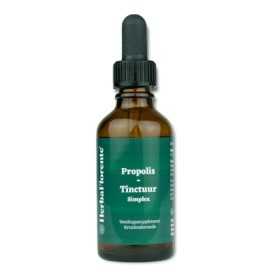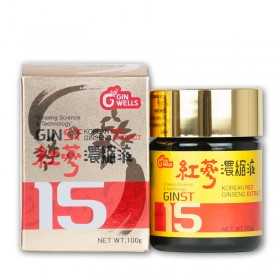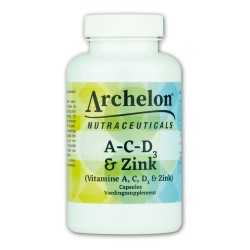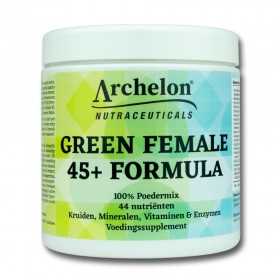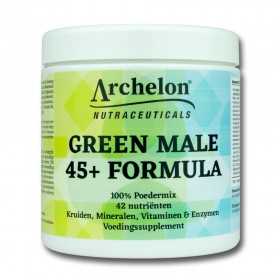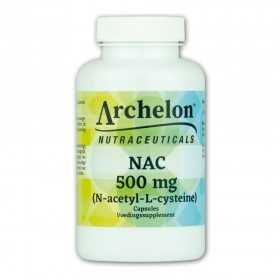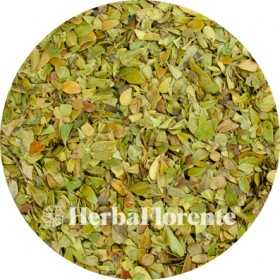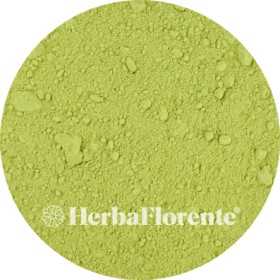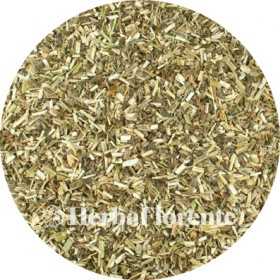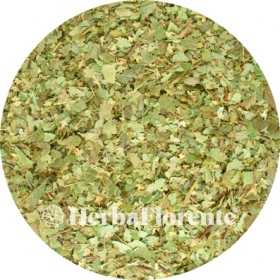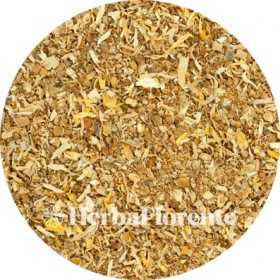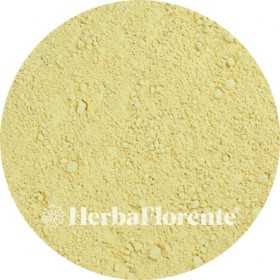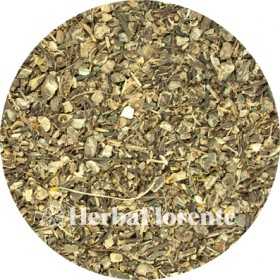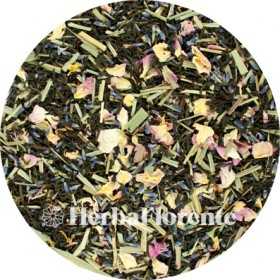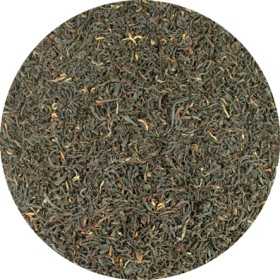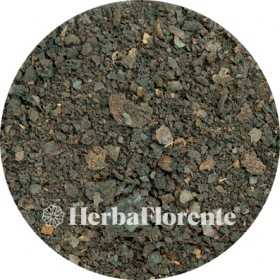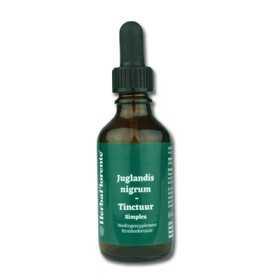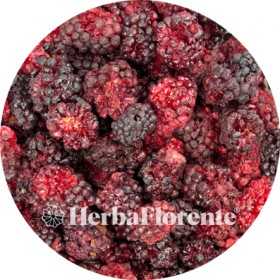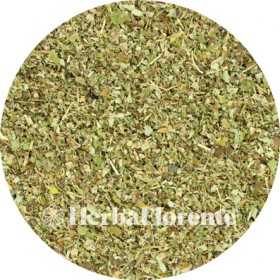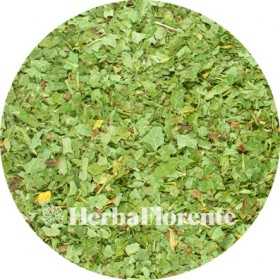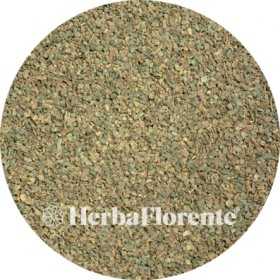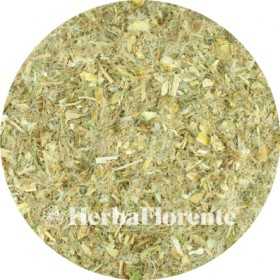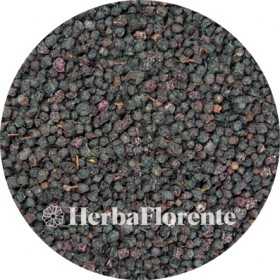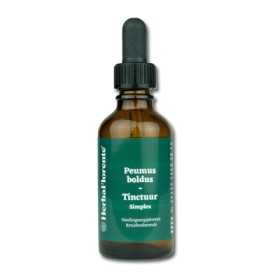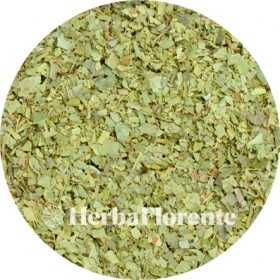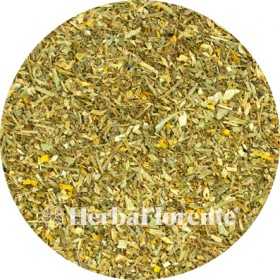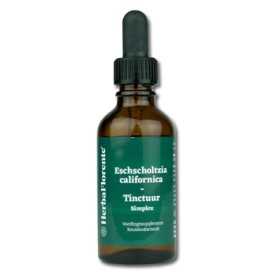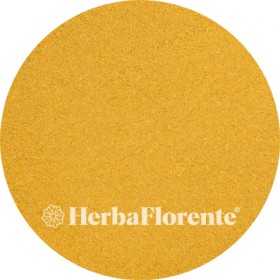List of products by brand HerbaFlorente
There are 286 products.
Bearberry - Arctostaphylos uva-ursi - Cut
The bearberry (Arctostaphylos uva-ursi) is a plant from the heather family (Ericaceae). The Dutch name "bearberry" refers to the assumption that bears would be fond of the fruits of this plant.
The scientific name Arctostaphylos uva-ursi is a tautological mixture of Greek and Latin. The Greek 'arktos' and the Latin 'ursus' both mean "bear", while 'staphyle' and 'uva' both mean "grape".
This plant is known for its supportive effect on the urinary tract. As early as the thirteenth century, bearberry was mentioned in herbal books and praised for its beneficial effects on the bladder.
The scientific name Arctostaphylos uva-ursi is a tautological mixture of Greek and Latin. The Greek 'arktos' and the Latin 'ursus' both mean "bear", while 'staphyle' and 'uva' both mean "grape".
This plant is known for its supportive effect on the urinary tract. As early as the thirteenth century, bearberry was mentioned in herbal books and praised for its beneficial effects on the bladder.
€2.40
From: €2.40
Berk - Betula pendula Roth, Betulae (Leaf Grounded)
Birch (Betula) has been valued for centuries for its beneficial properties, thanks to the presence of bioactive substances. In the past it was even considered a sacred tree. In the spring, just before the tree sprouts, birch sap is tapped because that is when the sap flow is strongest. This juice is full of phytonutrients, minerals and vitamins. The young leaves are then collected, because they also contain a high content of various beneficial substances during this period.Birch leaf is rich in flavonoids, saponins and tannins. The saponins and tannins are responsible for the diuretic properties of the birch.
€2.10
From: €2.10
Betony - Wood Betony - Betonica officinalis
Betony (Betonica officinalis, synonym: Stachys officinalis) is a herbaceous plant from the Lamiaceae family. In the Netherlands and Belgium, the species is on the Red List of plants, where it is classified as very rare and has declined sharply in numbers. In addition to its natural occurrence, betony is also often cultivated as an ornamental plant.
The plant reaches a height of 30–90 cm and blooms from June to August with purple-red flowers, although white varieties sometimes occur. The flowers are in dense, spike-shaped false inflorescences. Most leaves form a basal rosette: the lower leaves have long petioles, while the upper leaves have short petioles. All leaves have a reticulate venation. The stem is unbranched, square in shape and covered with short hairs.
The plant reaches a height of 30–90 cm and blooms from June to August with purple-red flowers, although white varieties sometimes occur. The flowers are in dense, spike-shaped false inflorescences. Most leaves form a basal rosette: the lower leaves have long petioles, while the upper leaves have short petioles. All leaves have a reticulate venation. The stem is unbranched, square in shape and covered with short hairs.
€3.20
From: €3.20
Birch - Betula pendula Roth, Betulae (Leaf Cut)
The Birch (Betula) has been valued for centuries for its beneficial properties, thanks to the presence of bioactive substances. In the past, it was even considered a sacred tree. In the spring, just before the tree starts to leaf out, birch sap is tapped because the sap flow is strongest then. This sap is full of phytonutrients, minerals and vitamins. The young leaves are then collected, because they also contain a high content of various beneficial substances during this period.
Birch leaf is rich in flavonoids, saponins and tannins. The saponins and tannins are responsible for the diuretic properties of the birch.
Birch leaf is rich in flavonoids, saponins and tannins. The saponins and tannins are responsible for the diuretic properties of the birch.
€2.10
From: €2.10
Birch - Butla alba, Betulae (Bark Cut)
Birch (Betula) has been valued for centuries for its beneficial properties, thanks to the presence of bioactive substances. In the past it was even considered a sacred tree. In the spring, just before the tree sprouts, birch sap is tapped because that is when the sap flow is strongest. This juice is full of phytonutrients, minerals and vitamins.
Birch is rich in flavonoids, saponins and tannins. The saponins and tannins are responsible for the diuretic properties of the birch. Birch supports, among other things, kidney function and a healthy urinary tract, and is beneficial for the liver. In addition, it promotes joint health and contributes to maintaining normal cholesterol levels.
Birch is rich in flavonoids, saponins and tannins. The saponins and tannins are responsible for the diuretic properties of the birch. Birch supports, among other things, kidney function and a healthy urinary tract, and is beneficial for the liver. In addition, it promotes joint health and contributes to maintaining normal cholesterol levels.
€2.00
From: €2.00
Bitterhout - Quassiae
Quassia, known in Surinamese as kwasibita, is the heartwood of the Quassia amara, a plant species from the Quassia genus within the Tree of Heaven family. This South American plant is often planted in the tropics for its use as a remedy for malaria.
Quassia amara is a small, evergreen shrub found in tropical South America, particularly the Guianas, northern Brazil and Venezuela. The plant grows in the understory of the rainforest and its striking red flowers are pollinated by hummingbirds. Because of these beautiful flowers, the plant is also often planted for decorative purposes.
Quassia amara is a small, evergreen shrub found in tropical South America, particularly the Guianas, northern Brazil and Venezuela. The plant grows in the understory of the rainforest and its striking red flowers are pollinated by hummingbirds. Because of these beautiful flowers, the plant is also often planted for decorative purposes.
€2.80
From: €2.80
Black Cohosh - Cimicifuga Racemosa
Black cohosh (Cimicifuga racemosa), has been used in North American herbal medicine for centuries. The roots of this plant have been used for centuries by northern Indian tribes, where it is known as "squawroot" (where 'squaw' refers to 'Indian woman'). Black cohosh is best known as an herb specifically aimed at women and is becoming increasingly popular in the Netherlands. It provides support for menopausal symptoms such as hot flashes and irritable feelings.
€9.80
From: €9.80
Black Pepper - Piper nigrum
Pepper is a commonly used spice in cooking, known for its sharp taste. It is obtained from the berries of the tropical pepper plant, Piper nigrum. The pungency of black peppercorns comes from the component piperine. Pepper comes in different colors, including black, white and green.
It can be used in virtually any dish and enhances the flavor of meat while adding a spicy note to soups and purees. Sometimes pepper is also used in baking products, such as gingerbread, albeit in moderate amounts. Whole peppercorns, dried berries of the pepper plant, are used in some dishes. Although pepper is also available ground, many gourmets prefer freshly ground pepper. In addition, pepper is also often used fresh. In India, pepper is added to the spiciest curry mixtures.
It can be used in virtually any dish and enhances the flavor of meat while adding a spicy note to soups and purees. Sometimes pepper is also used in baking products, such as gingerbread, albeit in moderate amounts. Whole peppercorns, dried berries of the pepper plant, are used in some dishes. Although pepper is also available ground, many gourmets prefer freshly ground pepper. In addition, pepper is also often used fresh. In India, pepper is added to the spiciest curry mixtures.
€3.00
From: €3.00
Black Tea - Flowers Herbal Tea
Herbal tea composed of various herbs
Delicious for every moment
Delicious for every moment
€3.95
Black Tea Assam - Camellia sinensis
Black Tea Assam is a black tea from the state of the same name in India. Since 1838, this tea has also been drunk outside India, but in the first 25 years it could not compete with the already popular Japanese and Chinese teas, which had been popular in Europe since the 17th century. Today, about half of the total Indian tea production comes from Assam, making this region more popular than the other famous Indian teas: Darjeeling and Nilgiri.
€2.95
From: €2.95
Black Walnut - Juglandis nigrum
The shell of the black walnut (Juglans nigra) comes from the immature fruits of the black walnut tree (Juglans nigra).
Black walnut (Juglans nigra, also known as 'black nut') is a species of walnut that grows naturally only in the United States and Canada, hence the term American black walnut. Juglans nigra belongs to the walnut family.
The fruits are dark brown and have a strong odor distinct from European walnuts. In America, the use of black walnut has long been common among herbalists. It is often used in the form of an extract or tincture in herbal medicine, because this way the active substances are optimally preserved. The fruits are edible and contain polyphenols, tannins, juglon, tannins and omega fatty acids.
Black walnut (Juglans nigra, also known as 'black nut') is a species of walnut that grows naturally only in the United States and Canada, hence the term American black walnut. Juglans nigra belongs to the walnut family.
The fruits are dark brown and have a strong odor distinct from European walnuts. In America, the use of black walnut has long been common among herbalists. It is often used in the form of an extract or tincture in herbal medicine, because this way the active substances are optimally preserved. The fruits are edible and contain polyphenols, tannins, juglon, tannins and omega fatty acids.
€2.50
From: €2.50
Black Walnut Tincture - Juglandis nigrum Tincture
Single herbal tincture made with the dried husk of Juglandis nigrum (Black Walnut).
The husk of the black walnut (Juglans nigra) comes from the immature fruit of the black walnut tree (Juglans nigra).
Black walnut (Juglans nigra, also known as 'black nut') is a type of walnut that grows naturally only in the United States and Canada, hence the term American black walnut. Juglans nigra belongs to the walnut family.
The husk of the black walnut (Juglans nigra) comes from the immature fruit of the black walnut tree (Juglans nigra).
Black walnut (Juglans nigra, also known as 'black nut') is a type of walnut that grows naturally only in the United States and Canada, hence the term American black walnut. Juglans nigra belongs to the walnut family.
€10.95
Blackberry (Fruit) - Rubus fructicosus, Frucus Rubi
Blackberries are not only delicious, but also extremely nutritious. They are packed with essential nutrients and dietary fiber. These dark purple treats are a rich source of vitamins C, E, K, folic acid and manganese, making them an important contribution to a healthy diet.
The intense purple color of blackberries is caused by anthocyanins, powerful antioxidants that protect our cells against harmful external influences. But it goes further than that. Blackberries are particularly rich in phenolic acids, which also have antioxidant properties. These acids, which include anthocyanins, ellagic acid, rutin, gallic acid, quercetin, cyanides, p-coumaric acid and cinnamic acid, provide numerous health benefits.
The intense purple color of blackberries is caused by anthocyanins, powerful antioxidants that protect our cells against harmful external influences. But it goes further than that. Blackberries are particularly rich in phenolic acids, which also have antioxidant properties. These acids, which include anthocyanins, ellagic acid, rutin, gallic acid, quercetin, cyanides, p-coumaric acid and cinnamic acid, provide numerous health benefits.
€10.00
From: €10.00
Blackberry (Leaf) - Rubus fructicosus, Frucus Rubi
The genus Blackberry (Rubus) belongs to the rose family and has more than 1400 species worldwide. More than 200 of these species grow in the Netherlands and Belgium.
Blackberries are prized primarily for their fruits, which range in color from red to dark blue. They have a sweet taste and can be eaten fresh or processed into jam, for example.
The leaves of the blackberry can be used to make herbal tea. After picking, the leaves should be dried in a dry and airy place, after which they can be used to make tea.
Blackberries are prized primarily for their fruits, which range in color from red to dark blue. They have a sweet taste and can be eaten fresh or processed into jam, for example.
The leaves of the blackberry can be used to make herbal tea. After picking, the leaves should be dried in a dry and airy place, after which they can be used to make tea.
€2.00
From: €2.00
Blackcurrant - Ribes nigrum
The Latin name for blackcurrant is Ribes nigrum L. 'Nigrum' refers to the dark color and 'ribes' to the berries themselves. Various parts of the blackcurrant plant are attributed with different health benefits. The berries, seeds and leaves exhibit unique properties. For example, blackcurrant leaves are used to maintain healthy cartilage and to keep the joints flexible.
€2.95
From: €2.95
Bladder Herbal Tea
Herbal tea composed of various herbs
Bladder support
Bladder support
€3.95
Bladderwrack Fine - Fucus vesiculosus
Bladderwrack (Fucus vesiculosus) is a type of brown algae belonging to the genus Fucus. It thrives along the northern coasts of the Atlantic and Pacific Oceans, and in the North Sea and Baltic Sea, often found in kelp forests. This seaweed is characterized by air bladders that serve as a floating organ, although there are also variants without these bladders.
Like other brown algae, bladderwrack is rich in a specific class of polyphenols called phlorotannins, which possess powerful antioxidant properties. In addition, these phlorotannins have antibiotic, antifungal and anti-inflammatory properties.
Like other brown algae, bladderwrack is rich in a specific class of polyphenols called phlorotannins, which possess powerful antioxidant properties. In addition, these phlorotannins have antibiotic, antifungal and anti-inflammatory properties.
€2.50
From: €2.50
Blessed Thistle - Centaurea benedicta
Centaurea benedicta, commonly known as St. Benedict's Thistle, blessed thistle, holy thistle, spotted thistle or dissolved knapweed, is a thistle-like plant belonging to the family Asteraceae. Originally native to the Mediterranean region, it ranges from Portugal and southern France to Iran. Outside its native habitat it is often found as a systematic species and in some regions such as North America it is observed as a conventional weed.
This annual plant grows up to 60 cm tall and has leathery, hairy leaves that can reach 30 cm long and 8 cm wide.
This annual plant grows up to 60 cm tall and has leathery, hairy leaves that can reach 30 cm long and 8 cm wide.
€2.25
From: €2.25
Blue Berrie - Vaccinium mytrillus, Frucus myrtilli
The blueberry (Vaccinium myrtillus) is not only nutritious, but also extremely popular. These berries are extremely low in calories and are often labeled as a superfood. Although low in calories, blueberries are packed with beneficial nutrients, including antioxidants like flavonoids and anthocyanins.
Additionally, they contain a wide range of other compounds, including folic acid, vitamins A and C, carotenoids, ellagic acid and fiber. The specific anthocyanins in blueberries contribute to normal eye function and provide support to the heart and blood vessels.
Additionally, they contain a wide range of other compounds, including folic acid, vitamins A and C, carotenoids, ellagic acid and fiber. The specific anthocyanins in blueberries contribute to normal eye function and provide support to the heart and blood vessels.
€8.20
From: €8.20
Boldo Tincture - Peumus boldus Tincture
Single herbal tincture made with dried leaf of Peumus boldus (Boldo).
Boldo (Peumus Boldus) is a versatile plant with a long history of positive effects on the liver, bile and digestion. It contains a combination of alkaloids, essential oils, flavonoids and tannins, which together provide these beneficial properties. By supporting the liver and bile and promoting healthy digestion, boldo is a valuable addition to a healthy lifestyle. In addition, boldo strengthens the immune system and acts as a powerful antioxidant.
Boldo (Peumus Boldus) is a versatile plant with a long history of positive effects on the liver, bile and digestion. It contains a combination of alkaloids, essential oils, flavonoids and tannins, which together provide these beneficial properties. By supporting the liver and bile and promoting healthy digestion, boldo is a valuable addition to a healthy lifestyle. In addition, boldo strengthens the immune system and acts as a powerful antioxidant.
€10.95
Boldoblad - Peumus boldus
Boldo (Peumus Boldus) is a versatile plant with a long history of positive effects on the liver, bile and digestion. It contains a combination of alkaloids, essential oils, flavonoids and tannins, which together provide these beneficial properties. By supporting the liver and bile and promoting healthy digestion, boldo is a valuable addition to a healthy lifestyle. In addition, boldo strengthens the immune system and acts as a powerful antioxidant.
€2.00
From: €2.00
California Poppy - Eschscholzia californica
California Poppy, also known as golden poppy (Eschscholtzia californica), is a plant with golden yellow flowers that belongs to the poppy family. It owes this name to its soothing properties, which help with natural, healthy sleep and stress reduction.
This plant is native to California, hence the name. The indigenous people of America traditionally used golden poppy as a sedative herb and to help them sleep better. The aerial parts of the golden poppy contain several active substances, including quinolide alkaloids, rutin, phytosterols, carotenoids and cyanogen glycosides.
This plant is native to California, hence the name. The indigenous people of America traditionally used golden poppy as a sedative herb and to help them sleep better. The aerial parts of the golden poppy contain several active substances, including quinolide alkaloids, rutin, phytosterols, carotenoids and cyanogen glycosides.
€2.00
From: €2.00
California Poppy Tincture - Eschscholtzia californica Tincture
Single herbal tincture made with dried herb of Eschscholtzia californica (California Poppy).
California Poppy, also known as golden poppy (Eschscholtzia californica), is a plant with golden yellow flowers that belongs to the poppy family. It owes this name to its soothing properties, which help with natural, healthy sleep and stress reduction.
This plant is native to California, hence the name. The indigenous people of America traditionally used golden poppy as a sedative herb and to help them sleep better. The aerial parts of the golden poppy contain several active substances, including quinolide alkaloids, rutin, phytosterols, carotenoids and cyanogen glycosides.
California Poppy, also known as golden poppy (Eschscholtzia californica), is a plant with golden yellow flowers that belongs to the poppy family. It owes this name to its soothing properties, which help with natural, healthy sleep and stress reduction.
This plant is native to California, hence the name. The indigenous people of America traditionally used golden poppy as a sedative herb and to help them sleep better. The aerial parts of the golden poppy contain several active substances, including quinolide alkaloids, rutin, phytosterols, carotenoids and cyanogen glycosides.
€10.95
Cat's Claw - Uncaria tomentosa
Cat's claw (Uncaria tomentosa) is a climbing plant that is native to the Amazon region of Brazil and Peru. It is highly valued in the Peruvian Amazon and is among the protected species. This plant is often called the 'sacred herb of the rainforest' because of its significance. The name 'cat's claw' or 'cat's claw' is derived from the small claw-like thorns at the base of the leaves, which resemble a cat's claws. These claws help the vine to wrap itself around trees and climb up to a hundred meters high!
€2.60
From: €2.60

